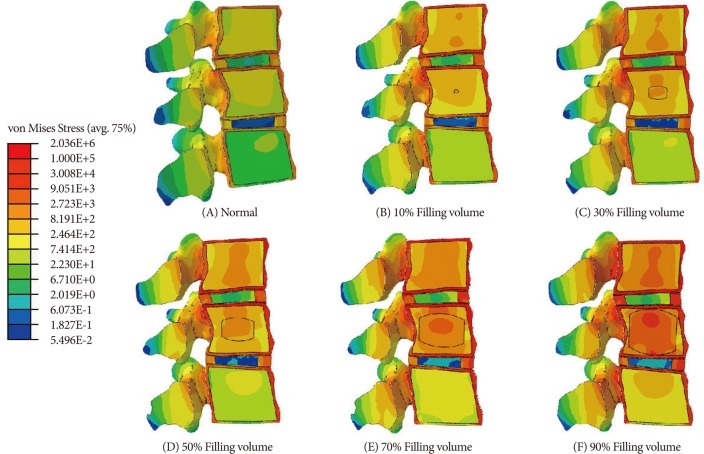J Korean Neurosurg Soc.
2012 Nov;52(5):435-440. 10.3340/jkns.2012.52.5.435.
Effect of Bone Cement Volume and Stiffness on Occurrences of Adjacent Vertebral Fractures after Vertebroplasty
- Affiliations
-
- 1Department of Medical System Engineering and Mechatronics, Gwangju Institute of Science and Technology, Gwangju, Korea. hyoungihl@gist.ac.kr
- 2Department of Neurosurgery, Yonsei University Health System, Seoul, Korea.
- 3Department of Neurosurgery, Presbyterian Medical Center, Jeonju, Korea.
- KMID: 2018248
- DOI: http://doi.org/10.3340/jkns.2012.52.5.435
Abstract
OBJECTIVE
The purpose of this study is to find the optimal stiffness and volume of bone cement and their biomechanical effects on the adjacent vertebrae to determine a better strategy for conducting vertebroplasty.
METHODS
A three-dimensional finite-element model of a functional spinal unit was developed using computed tomography scans of a normal motion segment, comprising the T11, T12 and L1 vertebrae. Volumes of bone cement, with appropriate mechanical properties, were inserted into the trabecular core of the T12 vertebra. Parametric studies were done by varying the volume and stiffness of the bone cement.
RESULTS
When the bone cement filling volume reached 30% of the volume of a vertebral body, the level of stiffness was restored to that of normal bone, and when higher bone cement exceeded 30% of the volume, the result was stiffness in excess of that of normal bone. When the bone cement volume was varied, local stress in the bony structures (cortical shell, trabecular bone and endplate) of each vertebra monotonically increased. Low-modulus bone cement has the effect of reducing strain in the augmented body, but only in cases of relatively high volumes of bone cement (>50%). Furthermore, varying the stiffness of bone cement has a negligible effect on the stress distribution of vertebral bodies.
CONCLUSION
The volume of cement was considered to be the most important determinant in endplate fracture. Changing the stiffness of bone cement has a negligible effect on the stress distribution of vertebral bodies.
Figure
Cited by 1 articles
-
Appropriate Cement Volume in Vertebroplasty: A Multivariate Analysis with Short-Term Follow-Up
Hyun Mook Kwon, Sang Pyung Lee, Jin Wook Baek, Seong Hwan Kim
Korean J Neurotrauma. 2016;12(2):128-134. doi: 10.13004/kjnt.2016.12.2.128.
Reference
-
1. Adams MA, Bogduk N, Burton K, Dolan P. The Biomechanics of Back Pain. 2002. Edinburgh, London, New York: Churchill Livingstone;p. 100.2. Anselmetti GC, Manca A, Hirsch J, Montemurro F, Isaia G, Osella G, et al. Percutaneous vertebroplasty in osteoporotic patients : an institutional experience of 1,634 patients with long-term follow-up. J Vasc Interv Radiol. 2011; 22:1714–1720. PMID: 22019853.
Article3. Aquarius R, Homminga J, Verdonschot N, Tanck E. The fracture risk of adjacent vertebrae is increased by the changed loading direction after a wedge fracture. Spine (Phila Pa 1976). 2011; 36:E408–E412. PMID: 21224753.
Article4. Bae H, Hatten HP Jr, Linovitz R, Tahernia AD, Schaufele MK, McCollom V, et al. A prospective randomized FDA-IDE trial comparing Cortoss with PMMA for vertebroplasty : a comparative effectiveness research study with 24-month follow-up. Spine (Phila Pa 1976). 2012; 37:544–550. PMID: 21738093.
Article5. Baroud G, Heini P, Nemes J, Bohner M, Ferguson S, Steffen T. Biomechanical explanation of adjacent fractures following vertebroplasty. Radiology. 2003; 229:606–607. author reply 607-608. PMID: 14595158.
Article6. Baroud G, Nemes J, Heini P, Steffen T. Load shift of the intervertebral disc after a vertebroplasty : a finite-element study. Eur Spine J. 2003; 12:421–426. PMID: 12687437.
Article7. Belkoff SM, Mathis JM, Erbe EM, Fenton DC. Biomechanical evaluation of a new bone cement for use in vertebroplasty. Spine (Phila Pa 1976). 2000; 25:1061–1064. PMID: 10788848.
Article8. Berlemann U, Ferguson SJ, Nolte LP, Heini PF. Adjacent vertebral failure after vertebroplasty. A biomechanical investigation. J Bone Joint Surg Br. 2002; 84:748–752. PMID: 12188498.9. Boger A, Heini P, Windolf M, Schneider E. Adjacent vertebral failure after vertebroplasty : a biomechanical study of low-modulus PMMA cement. Eur Spine J. 2007; 16:2118–2125. PMID: 17713795.
Article10. Boonen S, Wahl DA, Nauroy L, Brandi ML, Bouxsein ML, Goldhahn J, et al. Balloon kyphoplasty and vertebroplasty in the management of vertebral compression fractures. Osteoporos Int. 2011; 22:2915–2934. PMID: 21789685.
Article11. Hierholzer J, Fuchs H, Westphalen K, Baumann C, Slotosch C, Schulz R. Incidence of symptomatic vertebral fractures in patients after percutaneous vertebroplasty. Cardiovasc Intervent Radiol. 2008; 31:1178–1183. PMID: 18592307.
Article12. Kallmes DF, Comstock BA, Heagerty PJ, Turner JA, Wilson DJ, Diamond TH, et al. A randomized trial of vertebroplasty for osteoporotic spinal fractures. N Engl J Med. 2009; 361:569–579. PMID: 19657122.
Article13. Liebschner MA, Rosenberg WS, Keaveny TM. Effects of bone cement volume and distribution on vertebral stiffness after vertebroplasty. Spine (Phila Pa 1976). 2001; 26:1547–1554. PMID: 11462084.
Article14. McArthur N, Kasperk C, Baier M, Tanner M, Gritzbach B, Schoierer O, et al. 1150 kyphoplasties over 7 years : indications, techniques, and intraoperative complications. Orthopedics. 2009; 32:90. PMID: 19301801.15. Pérez-Higueras A, Alvarez L, Rossi RE, Quiñones D, Al-Assir I. Percutaneous vertebroplasty : long-term clinical and radiological outcome. Neuroradiology. 2002; 44:950–954. PMID: 12428134.16. Polikeit A, Nolte LP, Ferguson SJ. The effect of cement augmentation on the load transfer in an osteoporotic functional spinal unit : finite-element analysis. Spine (Phila Pa 1976). 2003; 28:991–996. PMID: 12768136.
Article17. Tanigawa N, Kariya S, Komemushi A, Tokuda T, Nakatani M, Yagi R, et al. Cement leakage in percutaneous vertebroplasty for osteoporotic compression fractures with or without intravertebral clefts. AJR Am J Roentgenol. 2009; 193:W442–W445. PMID: 19843725.
Article18. Trout AT, Kallmes DF. Does vertebroplasty cause incident vertebral fractures? A review of available data. AJNR Am J Neuroradiol. 2006; 27:1397–1403. PMID: 16908547.19. Trout AT, Kallmes DF, Kaufmann TJ. New fractures after vertebroplasty : adjacent fractures occur significantly sooner. AJNR Am J Neuroradiol. 2006; 27:217–223. PMID: 16418388.
- Full Text Links
- Actions
-
Cited
- CITED
-
- Close
- Share
- Similar articles
-
- Risk Factors of New Compression Fractures in Adjacent Vertebrae after Percutaneous Vertebroplasty
- Cement Leakage into Adjacent Vertebral Body Following Percutaneous Vertebroplasty
- Risk Factors for Subsequent Fracture after Osteoporotic Vertebral Compression Fracture
- The Proper Volume and Distribution of Cement Augmentation on Percutaneous Vertebroplasty
- Debates of the Effectiveness of Vertebroplasty





